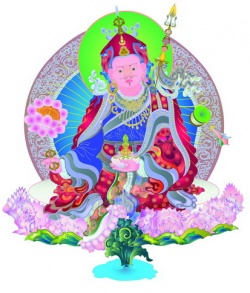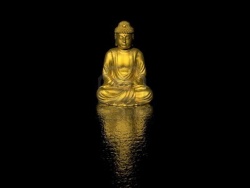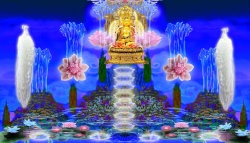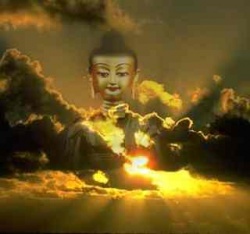Jhana
jhana (dhyana): Meditative absorption state in Pali.
See; "dhyana."
Jhana (Pali) Jhāna Meditation in wisdom, equivalent to Sanskrit jnana and dhyana.
This experience was originally divided into four states:
the mystic, with his mind free from sensuous and worldly ideas, concentrates his thoughts on some special subject such as the impermanence or mayavi character of all exterior things;
uplifted above attention to externals and ordinary reasoning he experiences keen joy and quiet ease both of body and mind;
the bliss passes away and he becomes suffused with a sense of inner completeness, in its higher stages approaching cosmic ranges;
he becomes aware permanently of purest lucidity of intellect and perfect equanimity, while his consciousness realizes wisdom.
In Buddhist texts, jhana is described as willful concentration upon an object, which does not cover the totality of jhana development nor its results.
Within Buddhist practice, the information available is concerned primarily with the development of Rupa (form) jhanas, and to a lesser extent the development of Arupa (formless) jhanas.
Thus, the concept of there being any other types of jhanas is somewhat alien, particularly as many Buddhists simply follow Buddhism as just another belief system without actually tasting the practice.
Concerning jhanas, there are two basic issues that elude the understanding of many people who simply refer to the established texts.
One is the condition, method or cause for attaining jhana, and the other is the result, absorption or effect achieved by successful practice.
Apart from the significant difference in conscious experience, the Rupa jhanas are obviously very useful in the development of concentration (samadhi) and collecting this samadhi (anuloma), and are rightly considered the most important jhanas in Buddhist practice, for introductory purposes at least.
The Arupa jhanas require experience of the development of Rupa jhanas plus the development of a conceptualized image (patibhaga nimitta) gained from Kasina practice, which offers a more exotic range of supernatural abilities.
This image is then expanded until it fills the whole space (kasinugghatimakasa) in the meditator’s mind, then the development of Arupa jhanas begins by using concepts.
Therefore, Arupa jhanas are not based upon anapanasati, mindfulness of breathing, as in the more basic Rupa jhanas, but require the development of a conceptualized image before one can even begin.
Thus, as in more basic meditative development like using mantras or practicing Metta meditation to attain first jhana, we find that the practice of anapanasati is only one method of attaining jhana, although samadhi still remains the key factor.
Many years ago in Thailand, there used to be one particular Ajarn who specialized in Kasina meditation.
Perhaps in the present time one of his students may still be continuing this tradition, and it may still be possible to pursue such meditative knowledge.
As for the higher knowledges that arise as Abhinnya, supernatural powers, these are also jhanas that require fourth Rupa jhana as their foundation and simply rely upon samadhi, samadhi and sati, and samadhi and a little something else, to go from there.
In the case of lokuttara (supramundane) jhanas, of which there is almost no mention in Buddhist texts, the basic requirement is the yahn or path knowledge of the first path realized through vipassana development.
This is then used as the object of samadhi, and while traditional anapanasati is no longer used, there is emphasis on the out breath, and staying there, using this yahn.
In the Abhidhamma, ‘Types of Consciousness’, in reference to supramundane consciousness, there are listed the supramundane jhanas for each path of Sotapanna, path of Sakadagami, path of Anagami, and path of Arahant.
In this section, the Abhidhamma also notes that ‘the wise’ will include these further classes of consciousness, meaning, perhaps, that most people who have not developed thus far will be absolutely clueless about their existence.
Effect
The successful attainment of mundane jhana is absorption, or the experience of another type of consciousness.
What is noticeable about Rupa and Arupa jhanas is that their change of consciousness refers to entry into another realm of existence, namely the Rupaloka (form) and Arupaloka (formless realms.
Interestingly, the development of Abhinnya, which begins in the pure abode form realms of Rupa jhana, will result in absorption into the Yama realm of the Devaloka celestial realms if one develops the celestial eye.
Thus, changes of consciousness through the development of mundane jhanas refer to instantaneous birth into the various realms of existence.
According to the earlier Brahman cosmology accepted in Buddhist practice, there are 31 such realms, therefore, minus our own human realm, we should at least be able to experience quite a few of these as jhanas.
Accepting that such cosmology is merely a description to make an extremely abstract subject fit into our human concept of understanding,
and taking note of the fact that some earlier civilizations have acknowledged an even larger number of possible realms of existence, the number of possible jhanas is probably quite phenomenal.
For some jhanas, like entry into the Deva realms, then one only has to spend some time with noble beings, the Ajarns with yahn or path knowledges.
While their knowledge is supramundane, their effect on those around them is mundane.
Thus, to experience instantaneous birth into the Devaloka one only has to go to the Wat.
Here, samadhi is still the key to entry, but in such situations it is the samadhi of the Ajarn; the candidate for instantaneous birth simply has to turn up.
Ordinary people succeed in changing their consciousness in a variety of ways, through the use of narcotic substances and even by using such things as flashing lights to numb the brain.
Who is to say where exactly their change in consciousness takes them?
We can, however, conclude that there are many jhanas, and that perhaps for the beings of some other realms there is even a jhana for the human realm.
Someone may perhaps notice that for the classes of consciousness experienced by the development of lokuttara jhanas there are no equivalent realms in earlier cosmology.
This is as it should be, as lokuttara consciousness is beyond all realms.
Do to a lack of direct experience by some scholars, in some later commentaries it has been suggested that fully aware beings, Arahants,
are capable of practicing mundane jhanas, which is simply not possible; nothing they do is mundane, and even those who have completed the first path cannot practice mundane jhanas.
Unfortunately, this has given risen to the idea that mundane jhanas are in some way connected to, or even close to nirvana, which could not be further from the truth.
While it is possible to consider certain similarities, mundane jhanas are based upon the suppression of defilements, not eradication.
When you consider that the development of mundane jhanas is based upon attachment to the five aggregates, the idea that an Arahant, after spending most of his life breaking free of all attachment, could somehow develop attachment once again to the causes of all suffering is somewhat beyond belief.
Finally, a word on the expression 'Lion's Roar', which is usually associated with the completion of meditative development.
This has often been described as a roar that the Arahant emits upon completion of his practice, which for someone who is supposed to be completely free of greed, anger and delusion certainly appears to be full of greed, anger and delusion.
Such an interpretation is simply the interpretation of an ordinary person, monk or otherwise; as if an Arahant would be impressed by his own accomplishments.
The real meaning of Lion's Roar is the certainty of mind of an Arahant.
If you think about the roar of a lion, then it is simply something that connotes authority.
Anyone who has spent much time around a fully aware being will have experienced the lion's roar;
perhaps just one word or an expression of the Ajarn's samadhi given with so much certainty, authority and power that everyone understands immediately.
This certainty and power comes from the void, not from any sense of accomplishment.
As for the idea of an Arahant showing some satisfaction with his state of mind, there is no one there to care less about anything.
see also;Dhyana




